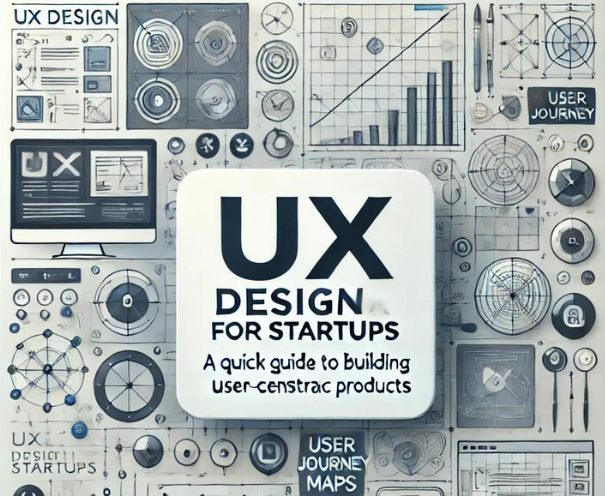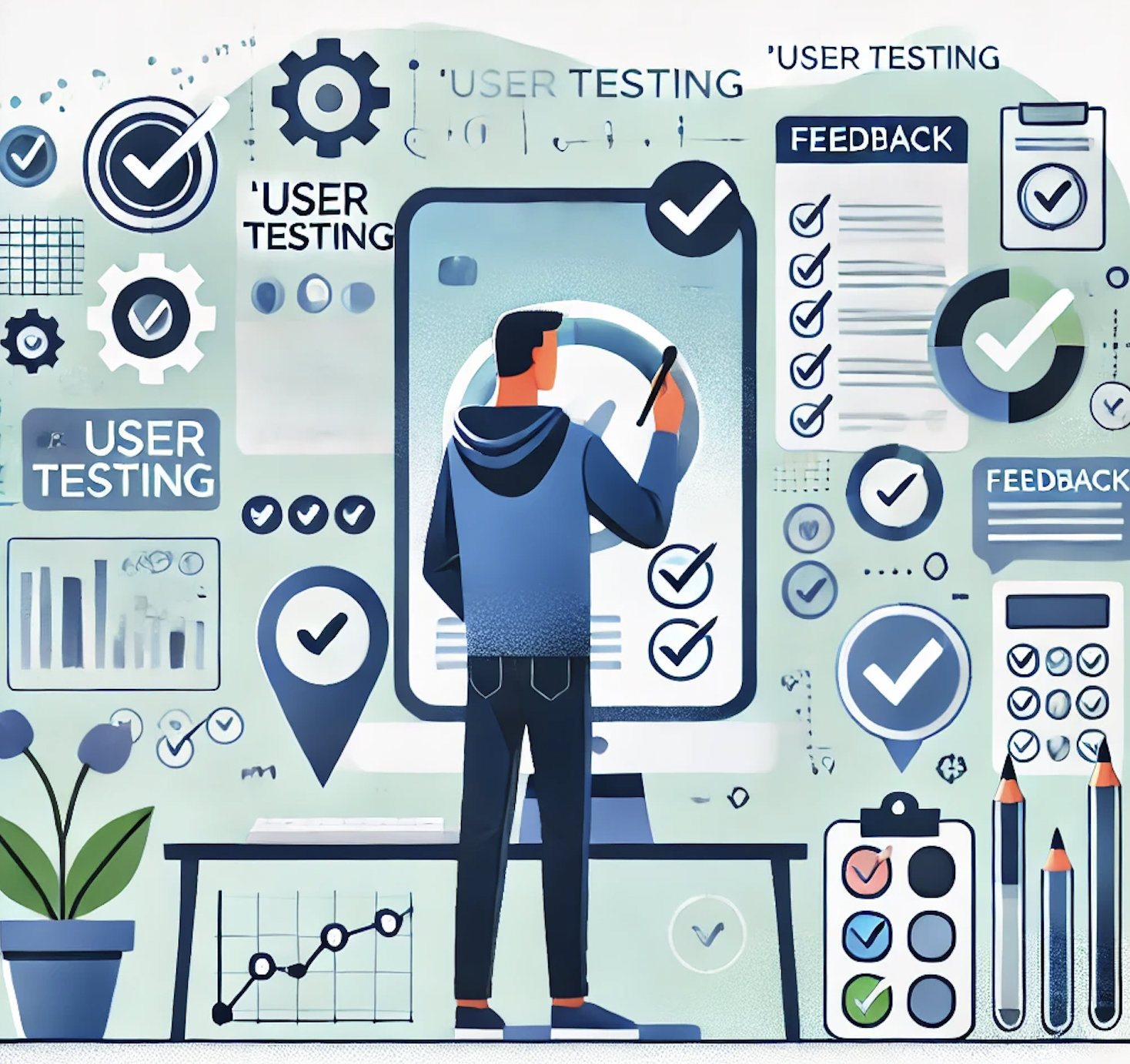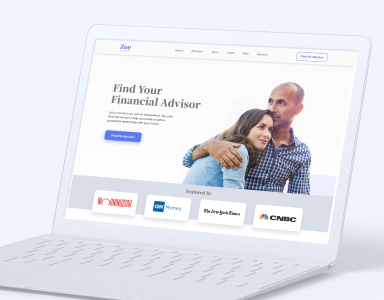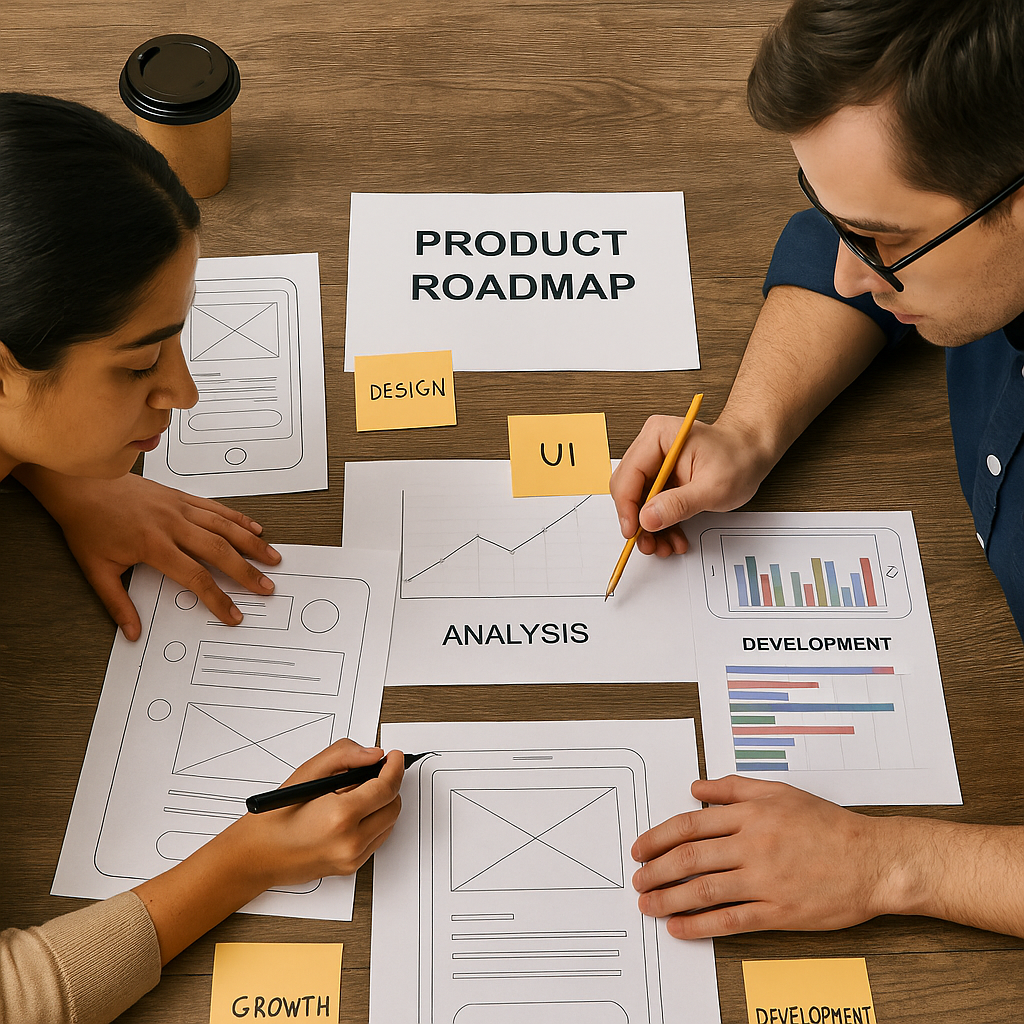articles
UX Design For Startups: Everything You Need to Know

User Experience (UX) design is a critical aspect of product development, especially for startups aiming to create successful and user-centric products. UX design focuses on understanding users' needs, behaviors, and motivations to craft intuitive and delightful experiences. In this article, we'll explore:
- What is User Experience Design?
- Users as the Center of UX Design
- Get to Know Your Users
- Efficient Design Techniques
- Optimization
- 6 Steps in a Design Process for Startups
- Takeaways
What is User Experience Design?
User Experience Design, often abbreviated as UX design, is creating products that provide meaningful and seamless experiences for users. It goes beyond visual aesthetics and focuses on understanding how users interact with a product, addressing their pain points, and optimizing their overall journey. A successful UX design involves research, wireframing, prototyping, testing, and iterative improvements to ensure the final product meets users' expectations and needs.
Users as the Center of UX Design
In UX design, the user is the primary focus. Understanding the target audience, their behaviors, preferences, and pain points is essential for creating a product that resonates with them. Startups should invest time and effort in user research, conducting interviews, surveys, and usability testing to gain insights into their potential customers. By empathizing with users and putting them at the center of the design process, startups can build products that genuinely address their needs and preferences, leading to higher user satisfaction and engagement.
Get to Know Your Users
User research is the foundation of successful UX design for startups. By conducting thorough research, startups can gather valuable data about their target audience, their goals, and pain points. This information informs the design decisions and ensures the product meets users' expectations. Additionally, understanding user behaviors and preferences helps identify product improvement and innovation opportunities.

Efficient Design Techniques
Startups operate in a fast-paced environment with limited resources and tight timelines. To thrive in such conditions, adopting efficient design techniques becomes paramount. These techniques enable startups to streamline their product development process, validate ideas rapidly, and make informed design decisions while maximizing time and cost efficiency. Here are some of the most influential and popular efficient design techniques used by startups:
1. Rapid Prototyping
Rapid prototyping involves creating quick and low-fidelity product versions to test ideas and gather feedback early in the design process. Instead of investing significant time and resources in developing a fully functional product, startups build simple prototypes that capture the core functionalities and interactions. These prototypes can be paper sketches, wireframes, or interactive mockups that simulate the user experience. By rapidly prototyping, startups can validate concepts, receive user feedback, and identify potential design flaws before diving into full-scale development. This iterative approach saves time and resources and increases the likelihood of creating a user-friendly and well-received final product.
2. Design Sprints
Design sprints, popularized by Google Ventures, are time-boxed and structured workshops that bring together cross-functional teams to tackle design challenges. Usually lasting five days, design sprints include understanding the problem, ideation, sketching, prototyping, and user testing. The condensed timeframe encourages rapid decision-making and collaboration, allowing startups to reach tangible outcomes quickly. Design sprints are especially beneficial when startups need to resolve critical design issues, validate new ideas, or kickstart a project. By the end of the sprint, startups have actionable insights and a validated prototype that serves as the foundation for further development.
3. Lean UX Methodologies
Lean UX is an iterative and collaborative design approach emphasizing quickly building and testing hypotheses. In this methodology, startups create a minimal viable product (MVP) with core features and design elements to gather user feedback and validate assumptions. The product is continually iterated and improved based on user insights, adding features that add value to the user experience. The lean UX process allows startups to avoid spending time on unnecessary features, focusing only on what truly matters to users. As a result, it optimizes time and resources while delivering a product that closely aligns with user needs and expectations.
4. User Journey Mapping
User journey mapping is a visual representation of the user's interactions and experiences with the product throughout their journey. Startups use this technique to identify pain points, emotional touchpoints, and opportunities for improvement. By understanding the entire user experience, startups can prioritize efforts on areas that matter most to users. User journey mapping is also beneficial for aligning cross-functional teams, providing a clear and shared understanding of the user's perspective.
5. Design Thinking
Design thinking is a problem-solving approach that puts human needs and desires at the forefront. It involves five stages: empathize, define, ideate, prototype, and test. Design thinking encourages startups to empathize with their users deeply, understand their challenges, and identify opportunities for innovative solutions. By fostering a creative and collaborative environment, design thinking empowers startups to think outside the box and develop products that genuinely resonate with users.
6. Continuous User Testing
User testing is an ongoing process in the efficient design approach. Instead of conducting extensive testing only at the end of the development cycle, startups continuously gather user feedback throughout the design and development process. Regular user testing ensures that the product is iteratively improved based on real user input. Startups can use various testing methods, such as usability testing, A/B testing, and feedback sessions, to gain insights into how users interact with the product and uncover areas that require refinement.
Incorporating these efficient design techniques into the product development enables startups to build user-centered and impactful products while optimizing time and resources. By embracing a lean and iterative approach to design, startups can respond quickly to market changes, adapt to user needs, and deliver compelling experiences that drive business growth and success.

Growth and Design Hacking: Fostering Sustainable Business Growth through User-Centric Design
In today's competitive business landscape, startups need to adopt innovative strategies that attract users and retain them for sustained growth. Growth hacking, a marketing approach focusing on rapid experimentation and data-driven decision-making, has gained immense popularity among startups for its ability to fuel user acquisition and retention. When combined with UX design, this powerful combination, known as design hacking, creates a potent framework for startups to optimize their product experiences and drive user growth in a scalable and sustainable manner.
Understanding Growth Hacking
Growth hacking is all about leveraging creativity, analytics, and a relentless focus on user acquisition and retention. Unlike traditional marketing strategies involving large budgets and lengthy campaigns, growth hacking emphasizes cost-effective and agile methods. Growth hackers prioritize experimentation and measure the impact of each tactic, refining strategies based on data-driven insights. The ultimate goal is to identify the most efficient and effective ways to attract and retain users, leading to rapid and sustainable growth for the startup.
The Role of UX Design in Growth Hacking
While growth hacking focuses on user acquisition and retention, UX design is pivotal in optimizing the entire user experience. Design hacking involves aligning the growth hacking strategy with a user-centered approach, ensuring that the product delivers an exceptional experience that keeps users engaged and returning for more. By integrating growth hacking with UX design, startups can create a seamless and compelling product experience that maximizes user satisfaction and fosters long-term loyalty.
Continuous Testing and Iteration
Design hacking thrives on the concept of continuous testing and iteration. Startups continuously experiment with design elements, user flows, and interface components to identify the most effective combinations. A/B testing is a common technique used to compare design variations to determine which resonates better with users. By analyzing user behavior and feedback, startups can refine their design elements iteratively, gradually improving the user experience to optimize user retention and growth.
Compelling User Onboarding
The onboarding process is fundamental in shaping users' initial interactions with the product. Design hacking ensures the onboarding experience is seamless, intuitive, and engaging. By providing users with a clear value proposition and guiding them through the product's core features, startups can increase user activation and reduce the chances of early drop-offs. A well-designed onboarding experience sets the foundation for a positive user journey, increasing the likelihood of users becoming loyal customers.
Personalization and Tailored Experiences
Design hacking also emphasizes personalization and tailoring experiences to individual users. By leveraging user data and insights, startups can customize the product experience to align with users' preferences and behaviors. Personalized experiences make users feel valued and understood, increasing their emotional connection with the product and driving user retention. Personalization can be achieved through personalized recommendations, content suggestions, and adaptive user interfaces that adapt to users' usage patterns.
Referral and Viral Loops
Design hacking can also harness the power of referral and viral loops to drive organic growth. By integrating frictionless referral mechanisms within the product, startups can encourage users to invite their friends and connections, expanding the user base organically. Viral loops occur when users invite others who, in turn, invite more users, creating a self-sustaining growth cycle. Careful design and optimization of referral mechanics are crucial to ensure that users find value in inviting others and that the process is seamless and rewarding.
Data-Driven Decision Making
At the core of design hacking lies data-driven decision-making. Startups collect and analyze user data to gain insights into user behavior, preferences, and pain points. This data guides the design process, informing design decisions and enhancements that align with user needs. By using analytics tools and user feedback, startups can continuously monitor the impact of design changes and refine their growth hacking strategies for optimal results.
Optimization: Fostering Continuous Improvement and User-Centric Enhancements
For startups, optimization is a never-ending journey that begins after the product launch and continues throughout its lifecycle. User Experience (UX) optimization involves collecting user feedback, analyzing user behavior, and making iterative improvements to enhance the overall user experience. By strongly emphasizing continuous optimization, startups can create a more refined and user-friendly product that aligns with users' evolving needs and preferences.
Data-Driven Decision Making
The heart of UX optimization lies in data-driven decision-making. Startups must utilize analytics tools and feedback mechanisms to collect valuable data about user interactions, pain points, and satisfaction levels. User feedback, both qualitative and quantitative, provides critical insights into areas where the product excels and where it falls short. By analyzing this data, startups can comprehensively understand the user journey and identify specific pain points or friction that need attention.
User Feedback and Surveys
Collecting user feedback through surveys, usability testing, and feedback forms is essential for optimization. Surveys can be conducted at different user journey stages to gauge satisfaction levels, identify areas for improvement, and uncover new opportunities. Usability testing involves observing users interacting with the product, allowing startups to pinpoint usability issues and areas that require streamlining. Feedback forms and support channels provide a direct channel for users to voice their concerns and suggestions, allowing startups to respond proactively and address issues promptly.
Analyzing User Behavior
Understanding how users interact with the product is a crucial aspect of UX optimization. Startups can use behavioral analytics tools to track user actions, navigation patterns, and engagement levels within the product. This data provides valuable insights into how users use the product, what features are popular, and which aspects need improvement. By understanding user behavior, startups can identify patterns and trends that inform the design and development of future iterations.
Iterative Improvements
UX optimization is not about making a single significant change but rather a series of incremental improvements. Startups should embrace an iterative approach, implementing small changes based on user feedback and data insights. Each iteration builds upon the previous one, gradually enhancing the product experience and addressing user pain points. An iterative approach also allows startups to test and validate new ideas before making significant investments in development, reducing the risk of costly design decisions.
Prioritization of Enhancements
With limited resources, startups must prioritize their optimization efforts wisely. Data-driven insights are crucial in determining which areas need immediate attention and which can be addressed in subsequent iterations. Startups should align optimization efforts with their overall business goals, and user needs to ensure that each enhancement has a meaningful impact on the user experience. By defining a clear prioritization framework, startups can focus on improvements that yield the most significant return on investment.
A/B Testing and Experimentation
A/B testing, or split testing, is valuable for optimizing design elements and user flows. By creating multiple variations of a feature or design element, startups can compare the performance of each version to identify the most effective one. This data-driven experimentation allows startups to make informed decisions, understanding which changes positively impact user behavior and which do not. A/B testing ensures that design choices are grounded in empirical evidence rather than assumptions.
User-Centered Mindset
Above all, UX optimization demands a user-centered mindset. Startups should always keep the end-users in mind and prioritize their needs and preferences throughout the optimization process. Every enhancement should aim to create a more delightful and intuitive user experience. By continuously seeking user feedback and involving users in the design process, startups can ensure that their product remains relevant, valuable, and user-friendly.
6 Steps in a Design Process for Startups
Designing a successful product for a startup requires a systematic and iterative approach. Here are the six essential steps in a design process that can help startups create user-centered and impactful products:
Step 1: Research
User research is the foundation of a robust design process. Startups must thoroughly understand their target audience, needs, behaviors, pain points, and expectations. This involves conducting surveys, interviews, and usability testing to gather valuable insights into user preferences and challenges. Additionally, competitor analysis helps identify existing solutions and potential areas for differentiation. By understanding their users deeply, startups can design products that truly resonate and provide value.
Step 2: The User Experience Journey Map
Once research data is gathered, creating a User Experience Journey Map becomes essential. This visual representation outlines the user's interactions with the product at each journey stage. It includes vital touchpoints, emotions, and pain points that users experience. By mapping out the entire user experience, startups can identify areas that need improvement and opportunities for enhancing the overall user journey. The journey map also aids in understanding how users move from one stage to another, which is crucial for product flow and conversion optimization.
Step 3: Define a Prioritization Framework
Startups often have limited resources and tight timelines, making prioritization a crucial aspect of the design process. Defining a prioritization framework helps the team identify the most critical features and design elements that align with user needs and business goals. By determining what needs to be developed first, startups can focus on the most impactful aspects of the product and iterate based on user feedback and data. This approach ensures that the product meets the core requirements while leaving room for additional features and enhancements in the future.
Step 4: Creating the Wireframe
With a clear understanding of the user journey and prioritized features, startups can move on to create wireframes. Wireframes are low-fidelity representations of the product's layout and structure, serving as a blueprint for the final design. They provide a visual guide to the product's functionality and help teams quickly iterate and adjust. Wireframes enable startups to validate their ideas before investing significant time and resources into high-fidelity designs. By focusing on the overall product flow and interaction patterns, startups can create a seamless user experience from the ground up.
Step 5: High Fidelity
The design moves to the high-fidelity stage after refining the wireframes and incorporating feedback. Here, the visual elements, colors, typography, and interactive components are added to the wireframes, creating a more realistic representation of the final product. High-fidelity designs allow stakeholders and users to visualize the product more accurately, providing a clearer understanding of the user experience. These designs also help build a cohesive brand identity and ensure visual consistency throughout the product.
Step 6: Testing and Revisions
Before launching the product, startups must conduct usability testing with real users. This step is critical for identifying any usability issues or design flaws that might have been overlooked during the design process. User feedback provides valuable insights into the product's strengths and weaknesses, allowing the team to make informed revisions and improvements. By iterating based on user input, startups can create a more polished and user-friendly product, increasing the likelihood of a successful launch and positive user reception.
Takeaways
UX design is a vital component for startups aiming to create successful and user-centered products. By putting users at the center of the design process, conducting thorough research, adopting efficient design techniques, and optimizing the product continuously, startups can create engaging and delightful experiences for their users. Embracing design hacking and combining growth hacking strategies with UX design further boosts user acquisition and retention. By following a structured design process that includes research, user journey mapping, prioritization, wireframing, high-fidelity design, testing, and revisions, startups can create products that resonate with users and drive business growth. Remember, a successful product is not just about building features; it's about crafting an experience that users will love and keep coming back to.
Remember that here in WANDR we offer a Startup Bootcamp that will take you from an idea to a solid head start in only four weeks.


.png)

